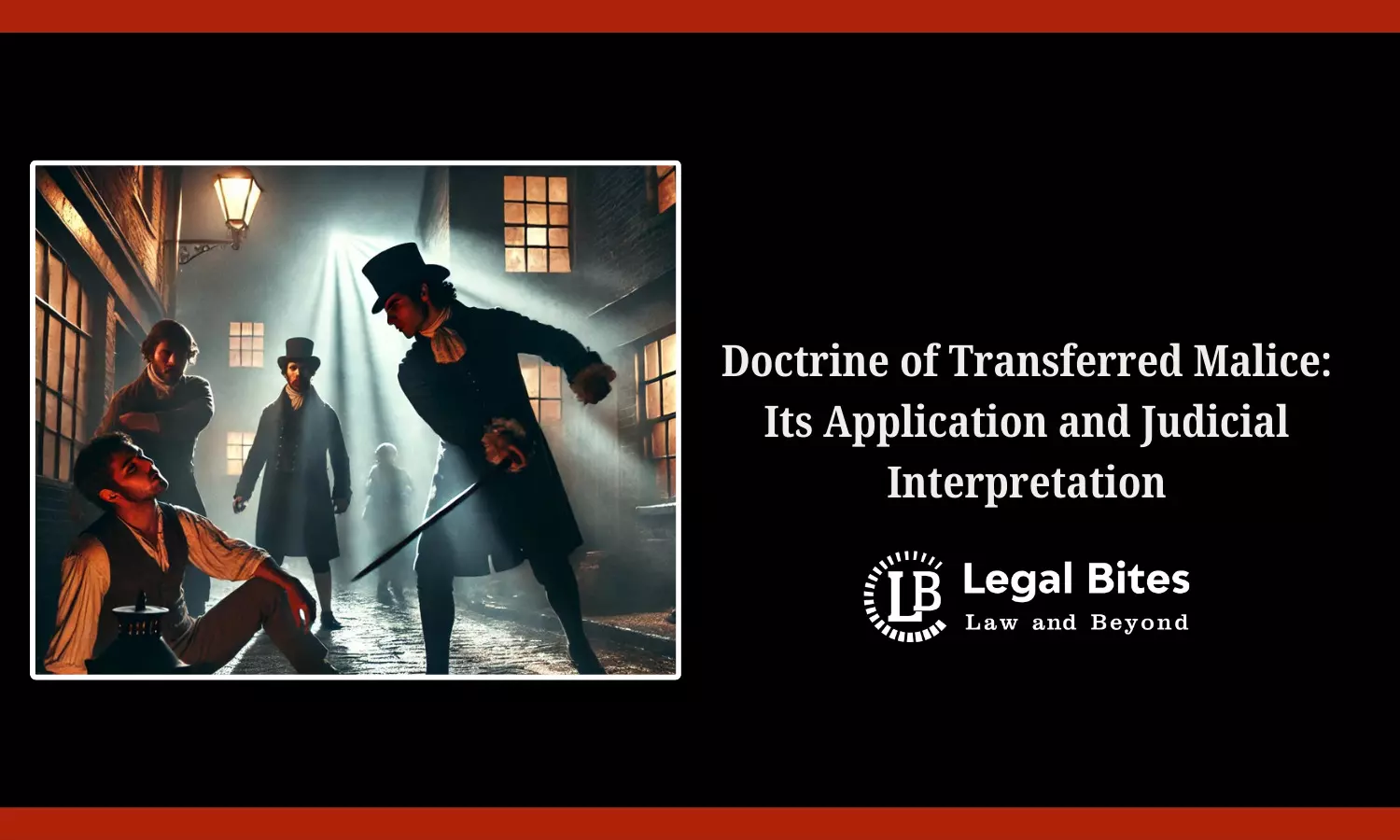Doctrine of Transferred Malice: Its Application and Judicial Interpretation
This article explores the principles of transferred malice, its application in the case of Ashok Saxena, and its broader implications in criminal jurisprudence.

Doctrine of transferred malice, also referred to as the transmigration of motive, is a crucial concept in criminal law that ensures an accused cannot escape liability simply because the actual victim was not their intended target. The Supreme Court of India, in Ashok Saxena v. State of Uttarakhand (2025), reaffirmed this doctrine while addressing an appeal concerning the reversal of an acquittal. In the words of P.H. Robinson & J. M. Darley, "there are two ways that the criminal...
Doctrine of transferred malice, also referred to as the transmigration of motive, is a crucial concept in criminal law that ensures an accused cannot escape liability simply because the actual victim was not their intended target. The Supreme Court of India, in Ashok Saxena v. State of Uttarakhand (2025), reaffirmed this doctrine while addressing an appeal concerning the reversal of an acquittal.
In the words of P.H. Robinson & J. M. Darley, "there are two ways that the criminal justice system may deviate from the community’s intuitions about appropriate criminal laws: by failing to punish actions that the community thinks are morally wrong, and by punishing actions that the community regards as morally innocent”.
Doctrine of Transferred Malice relates to Robinson & Darley’s observation, as it can sometimes lead to punishing individuals for unintended harms, which the community might perceive as morally unfair. This doctrine has its origins in English common law.
Doctrine of Transferred Malice
Transferred malice is an established principle in criminal law where an individual’s intent to commit harm against one person is legally extended to any other person who suffers as a consequence of the wrongful act. This doctrine ensures that criminal liability is not negated merely because the harm was inflicted on an unintended victim.
Under Section 301 of the Indian Penal Code (IPC) [Currently, Section 102 of Bharatiya Nyaya Sanhita (BNS)], if a person, by an act intended to cause death or bodily harm to one individual, causes the death of another, the culpability remains the same as if the intended victim had been harmed. The doctrine has significant implications in cases of indiscriminate violence, reckless conduct, and incidents where an act committed against one person inadvertently affects another.
Legal Precedents on Transferred Malice
Several past rulings by Indian and foreign courts have elaborated on the doctrine of transferred malice. The Supreme Court, in Gyanendra Kumar v. State of U.P. (AIR 1972 SC 502), applied this principle when an accused intending to shoot one individual accidentally killed another. Similarly, in Hari Shankar Sharma v. State of Mysore (1979 UJ 659 SC), the accused fired at a person but unintentionally killed another. The Court held that the liability remains the same under Section 301 IPC.
In Jagpal Singh v. State of Punjab (AIR 1991 SC 982), the accused fired at one individual but struck another, leading to a conviction under Section 302 IPC due to transferred malice. The Supreme Court also reaffirmed the doctrine in Abdul Ise Suleman v. State of Gujarat (1995 CrLJ 464), where an accused’s reckless firing resulted in the unintended death of a bystander.
In R v. Latimer (1886) 17 QBD 359, the defendant, during a heated argument in a pub, swung his belt at his opponent but unintentionally struck a nearby woman, causing severe injuries. Despite lacking intent to harm her, the court applied the doctrine of transferred malice, making him liable for her injuries.
Similarly, in R v. Mitchell (1983) QB 741, the defendant assaulted an elderly man in a post office queue, causing him to fall onto an elderly woman, who later succumbed to her injuries. Although the defendant had no direct intention to harm the woman, the court found him guilty of manslaughter under the principle of transferred malice.
In Commonwealth v. Gaynor (1994) 538 Pa. 258, during a duel between A and B, A accidentally shot a third party. The court applied the principle of transferred intent, holding A liable. The conviction was upheld based on doctrines such as foreseeable consequences, negligence, or replication of intent, provided the defendant’s mens rea was objectively assessed. The court emphasized that the attacker's actual state of mind was irrelevant to liability
These precedents demonstrate that as long as the act is unlawful and intended to cause harm, the accused cannot avoid liability even if the victim was not the one originally targeted.
Justification and Criticism of the Doctrine
Rationale Behind Transferred Malice
The doctrine of transferred malice is rooted in the fundamental principle that criminal liability should be based on the harm caused rather than on the identity of the victim. This ensures that offenders cannot escape punishment due to happenstance.
- Preserving Intent: The law recognizes that the moral culpability of an offender remains unchanged regardless of whether the intended victim or another person suffers harm.
- Public Safety: By ensuring that reckless and violent acts carry full legal consequences, the doctrine serves as a deterrent against crimes involving indiscriminate attacks.
- Legal Certainty: It provides a consistent framework for courts to assess liability in cases where the actual harm deviates from the original intention.
Criticisms of the Doctrine
Despite its utility, the doctrine has faced criticism for treating unintended harm as equal to intended harm:
- Ignores Subjective Intent: Critics argue that punishing an accused for the unintended killing of another person ignores the actual state of mind, which is a crucial factor in criminal law.
- Rigid Application: The doctrine does not account for situations where the offender may not have anticipated or foreseen the harm to the unintended victim.
- Potential for Miscarriage of Justice: In some cases, transferred malice can lead to disproportionate sentencing if courts fail to consider the nuances of each case.
Supreme Court’s Balancing Act in Ashok Saxena
The Supreme Court in Ashok Saxena recognized the validity of transferred malice but also acknowledged mitigating factors. While affirming the conviction under Section 301 IPC, the Court carefully examined the circumstances and ruled that the act fell under Exception 4 to Section 300 IPC. This ensured that the appellant was not unfairly punished with a life sentence and instead received a reduced sentence under Section 304 Part I IPC.
This judgment illustrates a balanced approach where the Court applied the doctrine of transferred malice but also considered the lack of premeditation and the age of the accused in deciding the sentence.
Case of Ashok Saxena v. State of Uttarakhand
(i) Background of the Case
The case arose from an altercation between the complainant’s son and the son of the co-accused at a typing institute. This minor dispute escalated into a violent confrontation when Ashok Saxena and Yashpal Singh allegedly attacked the complainant’s family at their home. The appellant, Ashok Saxena, reportedly intended to harm the complainant but instead inflicted a fatal knife wound on the complainant’s wife when she intervened.
The Trial Court acquitted the accused due to insufficient evidence. However, the High Court reversed the acquittal and convicted Ashok Saxena under Section 302 IPC (Section 103 of BNS). The Supreme Court later reviewed the case and modified the conviction to Section 304 Part I IPC (Section 105 of BNS), acknowledging the absence of premeditation and the application of Exception 4 to Section 300 IPC (Exception 4 to Section 101, BNS).
(ii) Application of Transferred Malice in the Case
The Supreme Court’s decision in this case relied heavily on Section 301 IPC, which embodies the principle of transferred malice. The Court noted that although Ashok Saxena may not have intended to kill the complainant’s wife, his deliberate and violent act towards another person resulted in her death. Thus, his culpability was determined based on the doctrine of transferred malice, making him liable for her killing as if she had been his original target.
Implications of the Judgment
I) Impact on Indian Criminal Law
The ruling in Ashok Saxena v. State of Uttarakhand has reinforced the application of transferred malice in Indian jurisprudence. Future cases involving unintended victims of violent acts will likely reference this decision to establish liability under Section 301 IPC.
II) Guidance for Legal Practitioners
For defence counsels, this case serves as a reminder that while transferred malice applies, exceptions to murder under Section 300 IPC can still be argued to mitigate sentences. Prosecutors, on the other hand, can rely on this doctrine to ensure that offenders are held accountable even when they harm unintended victims.
III) Humanitarian Considerations in Sentencing
The Supreme Court’s decision to consider the age of the appellant (74 years) and his time already served demonstrates that Indian courts are increasingly taking a nuanced view of sentencing. This could influence future cases where elderly convicts or those who have served substantial portions of their sentences seek clemency.
Conclusion
The doctrine of transferred malice plays a crucial role in ensuring that criminal liability is not evaded due to unforeseen consequences. The Supreme Court’s decision in Ashok Saxena v. State of Uttarakhand provides a clear reaffirmation of this principle while also demonstrating judicial flexibility in sentencing. By carefully balancing legal doctrines with individual circumstances, this case sets an important precedent for the future interpretation of transferred malice under Indian criminal law.
References
[1] Digvijay Singh, A Legal Analysis of the Transfer of Malice, Available Here
[2] Ashok Saxena v. State of Uttarakhand, Criminal Appeal Nos. 1704-1705 of 2015
[3] Indian Penal Code, 1860
[4] Bharatiya Nyaya Sanhita, 2023
[5] What is the Doctrine of Transferred Malice?, Available Here

Apurva Neel
I am a Research Associate and Editor at Legal Bites with an LL.M. specialization in Corporate and Commercial Laws from Amity University, Mumbai. I have put my best efforts into presenting socio-legal aspects of society through various seminars, conferences etc. I keep refining content as I am an ardent writer, and palpably law has got multi-dimensional aspect, so I passionately try to explore ahead.
